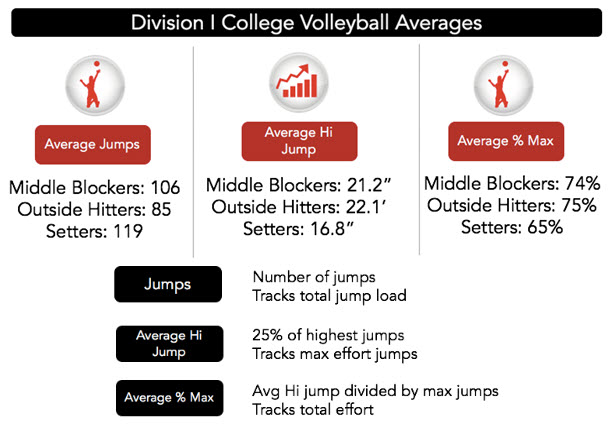In 2014 when I spent three weeks with a pair of German professional teams, I had a conversation with one coach about player jump counts. He was starting to use the VERT device to track jumps in training. It gave him a guideline as to when to shut things down. I had a similar conversation during one of the Volleyball Coaching Wizards interviews. It became the basis for a podcast.
All of this came after Volleywood posted something which suggested what I saw as a ridiculously high average player jump count. They said, “Most volleyball players jump about 300 times a match.” With no supporting evidence, I should note. I posted a comment contesting that idea. As this article shows, however, that idea somehow spread.
So what’s the truth?
The folks at VERT published a set of figures based on NCAA women’s volleyball. The following comes from an email they sent out which I received.
So setters jump the most, followed by middles, then outside hitters (probably including right sides). Notice none of them are anywhere close to 300. Yes, these are averages, but I’m hard-pressed to imagine any player in even the longest match getting to 300. Maybe, maybe hitters got that high back in the sideout scoring days when matches could go very long. Even then, that would be on the very high end, not the norm.
And according to the article I linked above, research indicates the average is significantly lower for beach players than indoor ones. Though for them you have to factor in playing multiple matches per day.
Training implications
So what does this mean for us as coaches?
It means it doesn’t make a whole lot of sense to have players do 150 or 200 jumps a day in practice when they will do far fewer in matches. If we do, then we are likely over-training, which puts us at risk of injury as a result of either fatigue or overuse. And we shouldn’t just think about jumps in practice here. We also have to consider jumps from strength training as well. It all adds up.
For more on the jump count subject check out Player Performance Accountability Utilizing Match Data.

6 Responses
Hi! I’m not sure if the data collected is per player or per position in a match.
Middle blockers average jumps: 106. Is this number considering the total of jumps of all the middle blockers in the match or the average jumps of ONE player (middle blocker)?
It is the average of each individual’s jumps in the position, not the sum of all player jumps in that position.
Just a couple questions. Very interested in the data you share here.
This is male or female?
This a real number using VERT?
How many samples you take?
Is coming from what volleyball level? (Junior club, college, professional level or national teams level?)
Even when MH jump on off and def and faking attacks they play only 3 rotations.Against 6 rotations of setter and OH with the grow of back rows attacks looks like the difference sounds not right. NOT saying is wrong because I did not make any real count yet, just asking to make sure. Thank you for sharing this, very important information.
Dardo – As noted in the article, the data is “based on NCAA women’s volleyball.” My guess is that means mainly Division I, but it could include other levels as well. I don’t know what you mean by “real number”, but I think it’s safe to assume since this comes from VERT that it’s based on jumps measured using VERT devices. I can’t speak to the sample size as that wasn’t included in the referenced email. If you want a deeper dive on the numbers I suggest you follow the link at the bottom of the article and watch that video. It features David Gil from VERT sharing all kinds of data.
(Asking for a friend) Hypothetically, you are an assistant coach again. From watching video of one 2-hour practice, you count that one MH jumped 216 times (not including a few baby-jumps). How do you approach starting that conversation with your head coach?
Depends when you notice. If it’s before the next practice, I’d say something like “We should probably give PLAYER a light load next practice. I counted her getting 216 jumps this last session.” And it would help having numbers for an average match for that player in case the coach is inclined to push back.
If you just randomly notice that count, I’d want to know if this is a regular thing or just some kind of one-off. Not that 216 jumps in a session is great any time, but it would be super worrying if there was a pattern of this happening. Then it would absolutely have to be addressed firmly – maybe with backing from a trainer.